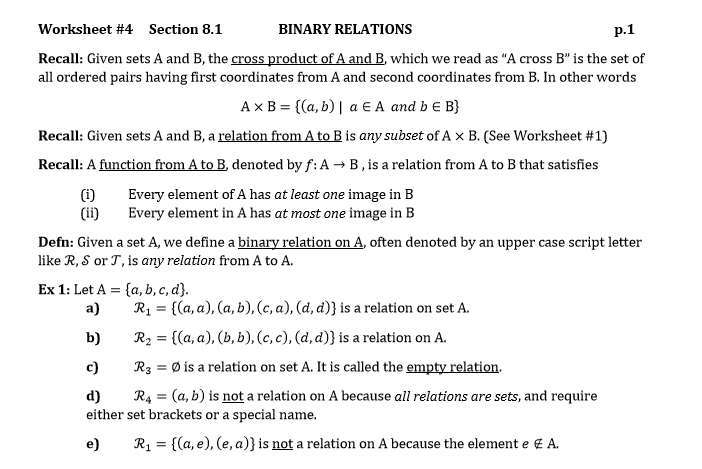Did Not Find Any Relations.
Introduction
In any written piece, the organization and structure play a pivotal role in conveying information effectively to the readers. Subheadings, in particular, serve as valuable tools for guiding readers through the content and enhancing overall readability. However, if subheadings are randomly chosen or poorly organized, the flow and coherence of the written piece can suffer. This article delves into the concepts, techniques, and strategies for establishing relationships among subheadings to create a cohesive structure that aids comprehension.
1. The Concept of Closely Related Subheadings
Closely related subheadings are those that share a common theme, topic, or purpose. When subheadings are appropriately aligned, they contribute to the overall coherence of the written piece and ensure a logical flow of information. Establishing relationships among subheadings not only assists the readers in smoothly navigating the content but also helps maintain the writer’s train of thought.
2. The Importance of Establishing Relationships Among Subheadings
The primary importance of establishing relationships among subheadings lies in enhancing the structure and organization of the written piece. Well-structured subheadings help readers understand the hierarchical relationships between different sections of the content, making it easier to grasp the main ideas and supporting details. Moreover, these relationships aid in creating a visual roadmap that guides readers through the text, ensuring a seamless flow of information.
3. Techniques for Identifying Related Subheadings
Identifying related subheadings requires careful analysis of the content and an understanding of the intended message. Some techniques that can assist in this process include:
a. Outlining the main ideas: Creating an outline of the content before assigning subheadings can help determine the logical flow of information and identify sections that are closely related.
b. Using keywords: Identifying keywords or phrases that frequently appear within the content can help identify subheadings that share the same topic or theme.
c. Analyzing content structure: Examining the organization of the written piece, including its paragraphs and sentences, can reveal patterns that aid in identifying related subheadings.
4. The Role of Coherence in Creating a Cohesive Subheading Structure
Coherence refers to the logical and meaningful connection between different parts of a written piece. When it comes to subheadings, coherence ensures that each section contributes to the overall message and understanding of the content. An incoherent subheading structure can confuse readers, making it difficult to follow the writer’s intended progression of ideas.
5. How to Organize Subheadings to Maintain Logical Flow
To maintain a logical flow within a written piece, subheadings should be organized hierarchically. This means that higher-level subheadings should encompass broader topics, while lower-level subheadings should delve into specific aspects related to the higher-level subheadings. This hierarchical organization helps readers understand the relationships between different sections and provides a clear roadmap of the content.
6. The Use of Subheadings to Guide the Reader and Enhance Readability
Subheadings serve as signposts for readers, guiding them through the content and facilitating easy navigation. By previewing the main idea of a section, subheadings allow readers to anticipate the upcoming information and locate specific details without reading the entire text. This enhances readability by reducing the cognitive load on readers and making the content more digestible.
7. The Limitations of Using Unrelated Subheadings
Using unrelated subheadings can lead to confusion and disarray within the written piece. When subheadings are disconnected, readers may struggle to comprehend the overall message or lose sight of the main ideas. This lack of coherence can result in an unsatisfactory reading experience and diminish the impact of the content.
8. Strategies for Reorganizing Subheadings to Enhance Coherence
If unrelated subheadings are identified or if the original organization does not adequately reflect the logical flow of information, certain strategies can be employed to enhance coherence. These include:
a. Revising subheadings: Altering the wording or content of subheadings to establish clearer relationships or align them with the main ideas of the text.
b. Rearranging subheadings: Changing the order of subheadings to ensure a more logical progression of ideas and a consistent flow.
c. Consolidating subheadings: Combining separate subheadings that cover similar concepts into a single, more comprehensive subheading.
9. The Impact of Related Subheadings on Overall Content Comprehension
Related subheadings significantly impact content comprehension by providing context and aiding in the logical organization of information. When subheadings are closely aligned, readers can easily locate relevant sections, understand the connections between ideas, and mentally structure their understanding of the content. This heightened comprehension enhances the effectiveness and impact of the written piece.
10. Tips for Creating Effective Subheadings that Strengthen the Structure of a Written Piece
To create subheadings that strengthen the structure of a written piece, consider the following tips:
a. Reflect the main ideas: Subheadings should accurately represent the main ideas within their respective sections, enabling readers to grasp the content at a glance.
b. Maintain consistency: Use consistent language and formatting throughout the subheadings to establish coherence and a sense of unity.
c. Avoid redundancy: Ensure that each subheading contributes unique information, avoiding repetition or duplication of ideas.
d. Focus on clarity: Keep subheadings concise and clear, allowing readers to understand their contents without confusion.
e. Review and revise: Regularly review and revise subheadings to maintain coherence and alignment with the main purpose of the written piece.
Conclusion
Establishing relationships among subheadings is crucial for creating a well-structured written piece that is easy to navigate and comprehend. By carefully selecting and organizing subheadings, writers can guide readers through the content, enhance readability, and convey their intended message effectively. Employing techniques for identifying related subheadings and adopting strategies to enhance coherence ensures that the structure of the written piece aligns with its content, leading to a more impactful and cohesive reading experience.
This Day In History: Bill Clinton Says \”I Did Not Have Sexual Relations With That Woman\”
Keywords searched by users: did not find any relations. Did not find any relations, Did not find any relation named, Relation does not exist, Relation employees does not exist, Org PostgreSQL util PSQLException ERROR: relation does not exist, SET default schema Postgres, Psql command, Create database postgres Ubuntu
Categories: Top 24 Did Not Find Any Relations.
See more here: nhanvietluanvan.com
Did Not Find Any Relations
When learning a new language, one of the most challenging aspects can be understanding and using correct grammatical structures and vocabulary. In English, a language known for its complex rules and exceptions, one common difficulty that learners encounter is the concept of not finding any relations. In this article, we will explore this topic in depth, providing explanations, examples, and tips to help you navigate this grammatical challenge.
Understanding the Concept
In English, the phrase “did not find any relations” refers to a situation where there is no connection or bond between people or things. This comes into play when there is no apparent similarity or association between individuals, objects, or ideas. It signifies a lack of connection and can be used in various contexts, such as personal relationships, scientific research, or investigative work.
Usage and Examples
To better comprehend the concept, let’s delve into a few examples across different scenarios.
1. Personal Relationships:
In personal relationships, “did not find any relations” may imply a lack of connection or compatibility. For instance, if someone goes on numerous dates but fails to establish a meaningful relationship, they might say, “I went on several dates but did not find any relations.” Here, the phrase reflects the absence of a meaningful bond or connection with any of the people they dated.
2. Scientific Research:
Researchers may use the phrase when discussing scientific studies or experiments that fail to establish a link or correlation between variables. For instance, if a group of scientists conducted a study to explore the effects of a new drug on a particular disease, but no positive outcomes were observed, they could conclude, “Our research did not find any relations between the drug and the disease symptoms.” In this case, the phrase conveys the lack of connection or correlation between the drug and the symptoms.
3. Investigative Work:
In investigative work, the phrase “did not find any relations” may be used to express the absence of connections or associations between various pieces of evidence. For example, if detectives are investigating a crime scene and fail to find any connections between the suspects and the evidence, they might state, “We analyzed the fingerprints and DNA samples, but did not find any relations between the suspects and the crime scene.” This usage denotes the lack of connections or links between the suspects and the evidence.
Handling the Phrase
Now that we have grasped the concept and seen some examples, let’s explore how to handle the phrase “did not find any relations” correctly.
1. Use it appropriately:
Ensure that you use the phrase only when it accurately reflects the absence of connections or associations between people, things, or ideas. Misusing the phrase can lead to confusion or miscommunication.
2. Consider alternatives:
Although “did not find any relations” can be an effective way to express a lack of connections, consider exploring alternative phrases that convey the same meaning. For instance, you might use phrases like “did not establish any connections” or “found no associations” to provide variety in your language usage.
3. Be specific:
When utilizing the phrase, it can be helpful to provide additional context or specify the domains in which the lack of relations occurred. This will help your listener or reader better understand the specific circumstances and context in which the phrase is being used.
FAQs:
Q: Can “did not find any relations” mean having no relatives or family members?
A: No, the phrase specifically refers to a lack of connections or associations between things or people. When discussing family relationships or relatives, it is more appropriate to use the term “did not have any blood relations” or “lacked any family connections.”
Q: Are there any other phrases or expressions that can be used interchangeably?
A: Yes, you can use alternative phrases such as “found no connections,” “observed no relationships,” or “discovered no affiliations” to convey the same meaning.
Q: Is this phrase commonly used in everyday conversations?
A: While it is not an everyday expression, it is useful in specific contexts like scientific research, personal relationship discussions, or investigative work. It may be encountered more frequently in specific professional or academic settings.
Q: Can the phrase be used in a positive context?
A: No, the phrase specifically denotes a lack of connections or associations, indicating a negative outcome in terms of seeking relations or links.
Q: Are there any cultural implications or variations in using this phrase?
A: The phrase “did not find any relations” is generally straightforward and carries no specific cultural implications or variations. However, cultural nuances in conversation style and choice of words may influence how it is used in different contexts.
In conclusion, understanding the concept of “did not find any relations” in English is crucial to navigate conversations and express the absence of connections or associations between people, objects, or ideas. By using this phrase appropriately and considering alternative expressions, you can effectively communicate the lack of relations in various contexts.
Did Not Find Any Relation Named
When it comes to human relationships, the English language is rich with words and expressions that encompass a wide range of emotional and social connections. From family members to friends, colleagues, and romantic partners, English provides various terms to define these relationships. However, there are instances when a specific relationship might not have a commonly known or widely accepted term in English. In this article, we will explore this aspect of the English language and delve into the reasons behind the absence of certain relationships in its vocabulary.
Why are some relationships not named in English?
Language is a reflection of culture, history, and social norms. The words we use to describe relationships are often shaped by these factors. English, like any other language, has evolved over time to encompass the relationships and concepts that were prevalent and relevant to the society in which it was spoken.
However, as society changes and evolves, so do our relationships. New forms of relationships emerge, and old ones may transform or become less significant. These changes may not always be immediately reflected in the language, resulting in the absence of specific relationship terms.
Furthermore, English is a language that has borrowed words and expressions from different cultures and countries throughout its history. Many languages have nuanced terms to describe certain relationships that have not been widely adopted or recognized in English. Cultural differences and variations in familial structures around the world can contribute to the absence of certain relationships in the English language.
Examples of relationships without specific English terms
While English may fall short in some cases, it is still a vast and encompassing language when it comes to relationships. However, below are a few examples of relationships that lack specific English terms:
1. “Paraparenting”: Some cultures have the concept of paraparenting, which refers to individuals other than biological or adoptive parents who participate in raising a child, such as close family friends or other trusted adults. English lacks a specific term to describe this relationship.
2. “In-laws once removed”: The concept of “in-laws once removed” refers to the relationship between a person and their spouse’s cousin. While English has the term “in-laws” to describe the relationships with a spouse’s family, it does not distinguish between different levels of cousins.
3. “Soulmate”: While the term “soulmate” is commonly used in English, it is not universally recognized or accepted as a legitimate relationship term. Its definition and significance can vary from person to person.
4. “Work spouse”: This term is used to describe a close relationship between two colleagues at work, often characterized by emotional support and a strong bond. Despite its popularity, it has not been officially adopted in the English language.
FAQs:
1. Are there any efforts to incorporate new relationship terms into the English language?
Yes, language is constantly evolving, and new words and expressions are regularly incorporated into English. With the growing diversity and changing dynamics of relationships, it is possible that new terms will emerge to fill the gaps in the language.
2. Can new terms be created to describe these relationships?
Absolutely! Language is fluid and flexible. Anyone can create new terms to describe relationships that they find lacking in English, and these terms may gain popularity and recognition over time.
3. Why is it important to have specific relationship terms?
Specific relationship terms can help us better understand and define our connections with others. They can provide a sense of belonging and identity by acknowledging the unique roles people play in our lives. Moreover, having specific terms for different relationships can facilitate communication and improve our ability to express our emotions and experiences.
4. What can we do if we feel the need for a specific relationship term?
If you feel the need for a specific relationship term, start using it in your conversations and writing to help popularize it. Share your ideas with others and encourage them to adopt the term as well. Language is a collective creation, and if enough people use and recognize a term, it has the potential to become widely accepted.
In conclusion, the English language encompasses a vast array of relationship terms, but there are some relationships that do not yet have specific terms in English. This can be due to historical, cultural, and societal factors. However, language is a dynamic entity, and new terms can be created and adopted as society evolves. Ultimately, having specific relationship terms can enrich our understanding of human connections and foster better communication.
Images related to the topic did not find any relations.

Found 50 images related to did not find any relations. theme











Article link: did not find any relations..
Learn more about the topic did not find any relations..
- dt says “Did not find any relations.” – DBA Stack Exchange
- Why command \dt gives – no relations found? – Stack Overflow
- Running \dt inside a psql shell results in “Did not find any …
- 3 ways to fix Did not find any relations in Postgresql
- Thread: did not find any relation for existing table
- List tables in Postgres database – Koen Woortman
- \dS: Did not find any relation named xyz : r/PostgreSQL – Reddit